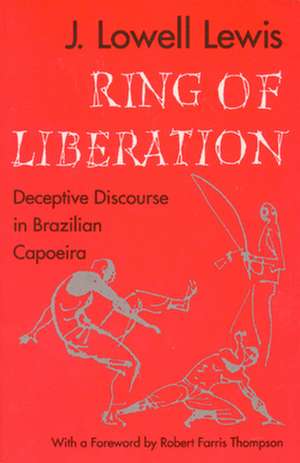Ring of Liberation: Deceptive Discourse in Brazilian Capoeira
Autor J. Lowell Lewisen Limba Engleză Paperback – 15 sep 1992
Based on eighteen months of intensive participant-observation, Ring of Liberation offers both an in-depth description of capoeira—a complex Afro-Brazilian martial art that combines feats of great strength and athleticism with music and poetry—and a pioneering synthetic approach to the analysis of complex cultural performance.
Capoeira originated in early slave culture and is practiced widely today by urban Brazilians and others. At once game, sport, mock combat, and ritualized performance, it involves two players who dance and "battle" within a ring of musicians and singers. Stunning physical performances combine with music and poetry in a form as expressive in movement as it is in word.
J. Lowell Lewis explores the convergence of form and content in capoeira. The many components and characteristics of this elaborate black art form—for example, competing genre frameworks and the necessary fusion of multiple modes of expression—demand, Lewis feels, to be given "body" as well as "voice." In response, he uses Peircean semiotics and recent work in discourse and performance theory to map the connections between physical, musical, and linguistic play in capoeira and to reflect on the general relations between semiotic systems and the creation and recording of cultural meaning.
Capoeira originated in early slave culture and is practiced widely today by urban Brazilians and others. At once game, sport, mock combat, and ritualized performance, it involves two players who dance and "battle" within a ring of musicians and singers. Stunning physical performances combine with music and poetry in a form as expressive in movement as it is in word.
J. Lowell Lewis explores the convergence of form and content in capoeira. The many components and characteristics of this elaborate black art form—for example, competing genre frameworks and the necessary fusion of multiple modes of expression—demand, Lewis feels, to be given "body" as well as "voice." In response, he uses Peircean semiotics and recent work in discourse and performance theory to map the connections between physical, musical, and linguistic play in capoeira and to reflect on the general relations between semiotic systems and the creation and recording of cultural meaning.
Preț: 259.08 lei
Nou
Puncte Express: 389
Preț estimativ în valută:
49.58€ • 53.01$ • 41.33£
49.58€ • 53.01$ • 41.33£
Carte tipărită la comandă
Livrare economică 18 aprilie-02 mai
Preluare comenzi: 021 569.72.76
Specificații
ISBN-13: 9780226476834
ISBN-10: 0226476839
Pagini: 294
Ilustrații: 25 figures, 2 maps, 3 tables
Dimensiuni: 140 x 216 x 18 mm
Greutate: 0.37 kg
Ediția:1
Editura: University of Chicago Press
Colecția University of Chicago Press
ISBN-10: 0226476839
Pagini: 294
Ilustrații: 25 figures, 2 maps, 3 tables
Dimensiuni: 140 x 216 x 18 mm
Greutate: 0.37 kg
Ediția:1
Editura: University of Chicago Press
Colecția University of Chicago Press
Cuprins
List of Maps, Tables, and Figures
Foreword, by Robert Farris Thompson
Preface
1. Introduction
2. The Origins of Capoeira
3. Capoeira in Salvador
4. Jogar—Body Play
5. Tocar—Musical Play
6. Brincar—Verbal Play
7. Conclusion
Appendix A: Laban Notation of Capoeira Ginga
Appendix B: Movement Repertoire
Appendix C: Names of Masters Cited
Notes
Glossary
Bibliography
Discography
Films and Videos
Index
Foreword, by Robert Farris Thompson
Preface
1. Introduction
2. The Origins of Capoeira
3. Capoeira in Salvador
4. Jogar—Body Play
5. Tocar—Musical Play
6. Brincar—Verbal Play
7. Conclusion
Appendix A: Laban Notation of Capoeira Ginga
Appendix B: Movement Repertoire
Appendix C: Names of Masters Cited
Notes
Glossary
Bibliography
Discography
Films and Videos
Index
